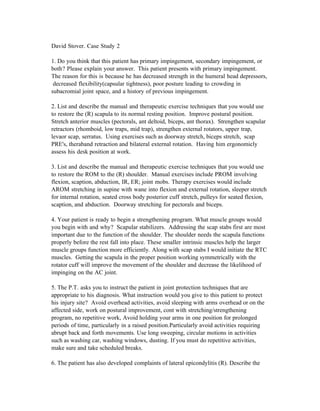Melden
Teilen
Downloaden Sie, um offline zu lesen

Empfohlen
Empfohlen
Weitere ähnliche Inhalte
Empfohlen
Empfohlen (20)
Product Design Trends in 2024 | Teenage Engineerings

Product Design Trends in 2024 | Teenage Engineerings
How Race, Age and Gender Shape Attitudes Towards Mental Health

How Race, Age and Gender Shape Attitudes Towards Mental Health
AI Trends in Creative Operations 2024 by Artwork Flow.pdf

AI Trends in Creative Operations 2024 by Artwork Flow.pdf
Content Methodology: A Best Practices Report (Webinar)

Content Methodology: A Best Practices Report (Webinar)
How to Prepare For a Successful Job Search for 2024

How to Prepare For a Successful Job Search for 2024
Social Media Marketing Trends 2024 // The Global Indie Insights

Social Media Marketing Trends 2024 // The Global Indie Insights
Trends In Paid Search: Navigating The Digital Landscape In 2024

Trends In Paid Search: Navigating The Digital Landscape In 2024
5 Public speaking tips from TED - Visualized summary

5 Public speaking tips from TED - Visualized summary
Google's Just Not That Into You: Understanding Core Updates & Search Intent

Google's Just Not That Into You: Understanding Core Updates & Search Intent
The six step guide to practical project management

The six step guide to practical project management
Beginners Guide to TikTok for Search - Rachel Pearson - We are Tilt __ Bright...

Beginners Guide to TikTok for Search - Rachel Pearson - We are Tilt __ Bright...
david stover case study 2
- 1. David Stover. Case Study 2 1. Do you think that this patient has primary impingement, secondary impingement, or both? Please explain your answer. This patient presents with primary impingement. The reason for this is because he has decreased strength in the humeral head depressors, decreased flexibility(capsular tightness), poor posture leading to crowding in subacromial joint space, and a history of previous impingement. 2. List and describe the manual and therapeutic exercise techniques that you would use to restore the (R) scapula to its normal resting position. Improve postural position. Stretch anterior muscles (pectorals, ant deltoid, biceps, ant thorax). Strengthen scapular retractors (rhomboid, low traps, mid trap), strengthen external rotators, upper trap, levaor scap, serratus. Using exercises such as doorway stretch, biceps stretch, scap PRE's, theraband retraction and bilateral external rotation. Having him ergonomicly assess his desk position at work. 3. List and describe the manual and therapeutic exercise techniques that you would use to restore the ROM to the (R) shoulder. Manual exercises include PROM involving flexion, scaption, abduction, IR, ER; joint mobs. Therapy exercises would include AROM stretching in supine with wane into flexion and external rotation, sleeper stretch for internal rotation, seated cross body posterior cuff stretch, pulleys for seated flexion, scaption, and abduction. Doorway stretching for pectorals and biceps. 4. Your patient is ready to begin a strengthening program. What muscle groups would you begin with and why? Scapular stabilizers. Addressing the scap stabs first are most important due to the function of the shoulder. The shoulder needs the scapula functions properly before the rest fall into place. These smaller intrinsic muscles help the larger muscle groups function more efficiently. Along with scap stabs I would initiate the RTC muscles. Getting the scapula in the proper position working symmetrically with the rotator cuff will improve the movement of the shoulder and decrease the likelihood of impinging on the AC joint. 5. The P.T. asks you to instruct the patient in joint protection techniques that are appropriate to his diagnosis. What instruction would you give to this patient to protect his injury site? Avoid overhead activities, avoid sleeping with arms overhead or on the affected side, work on postural improvement, cont with stretching/strengthening program, no repetitive work, Avoid holding your arms in one position for prolonged periods of time, particularly in a raised position.Particularly avoid activities requiring abrupt back and forth movements. Use long sweeping, circular motions in activities such as washing car, washing windows, dusting. If you must do repetitive activities, make sure and take scheduled breaks. 6. The patient has also developed complaints of lateral epicondylitis (R). Describe the
- 2. therapeutic exercise program that you would develop to address this diagnosis. Begin with AROM stretching of wrist/forearm muscles specifically wrist extensors. Strengthening of those same muscles. Work modification with keyboard/hand placement. Modalities to decreases pain and inflammation, cross friction and STM to lat epi and extensors. Possibly bracing. 7. Instruct your patient in protection techniques to decrease the risk of the lateral epicondylitis occurring again. Modify work. Check ergo with desk. No repetitive movements or static holds. Bracing. Keep up with exercise program and ice after overuse.